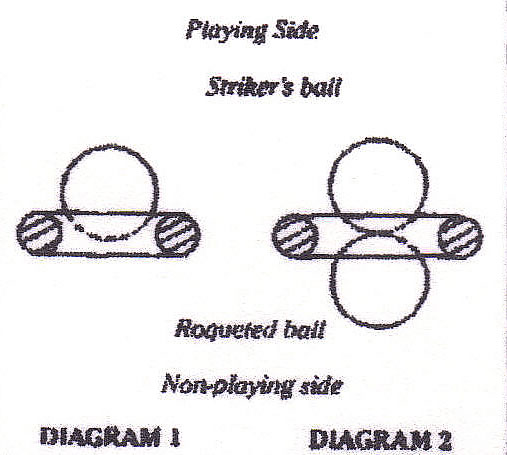
Cornwall Croquet Club
Coaching Comment by Bill Lamb (2010)
Coaching Comments by Bill Lamb (2010)
On two occasions this year (2010I have seen players come to grief on a four-ball break because they did not know the laws relating to hoop running.
On the first, an "A" class player, who should have known better, approached hoop 3 from behind with a pass roll off an opponents ball; his own ball ran backwards through the hoop and came to rest in the jaws, as shown in diagram 1. Under the impression that his ball had not gone far enough through the hoop to allow him to run it on his continuation shot, he hit hard through hoop 3 towards his partner ball at hoop 4. He was so bemused when the referee gave him his clip, that he missed the subsequent roquet.
On the second, a player twice within one game roqueted a ball into the jaws of the hoop he was approaching so that the roqueted ball was in the position shown in diagram 2. He then played an Irish peel backwards through the hoop to get into position to run it. As a result, he had no easy ball to roquet after running the hoop.
Now, although there are complicated situations in croquet, the law regarding when a ball starts to run a hoop is quite clear:
The front of the hoop as it is approached by a ball about to run it in order is know as the playing side and the back as the non-playing side A ball begins to run a hoop only when the front edge of the ball can be touched by a straight edge raised vertically against the non-playing side.
Thus in the first case described above(see diagram 1), the ball had not started to run hoop 3 even though it had entered the hoop from the non-playing side, on the croquet stroke. It was therefore perfectly permissable to run the hoop with the continuation stroke and and thus score the point.
In the second case, the striker's ball could have been placed for the croquet stroke in such a position that it had not started to run the hoop(see diagram 2). With an Irish peel or a little stop shot, both balls could then have been played to the non playing side of the hoop, leaving an easy return roquet after running ther hoop.
